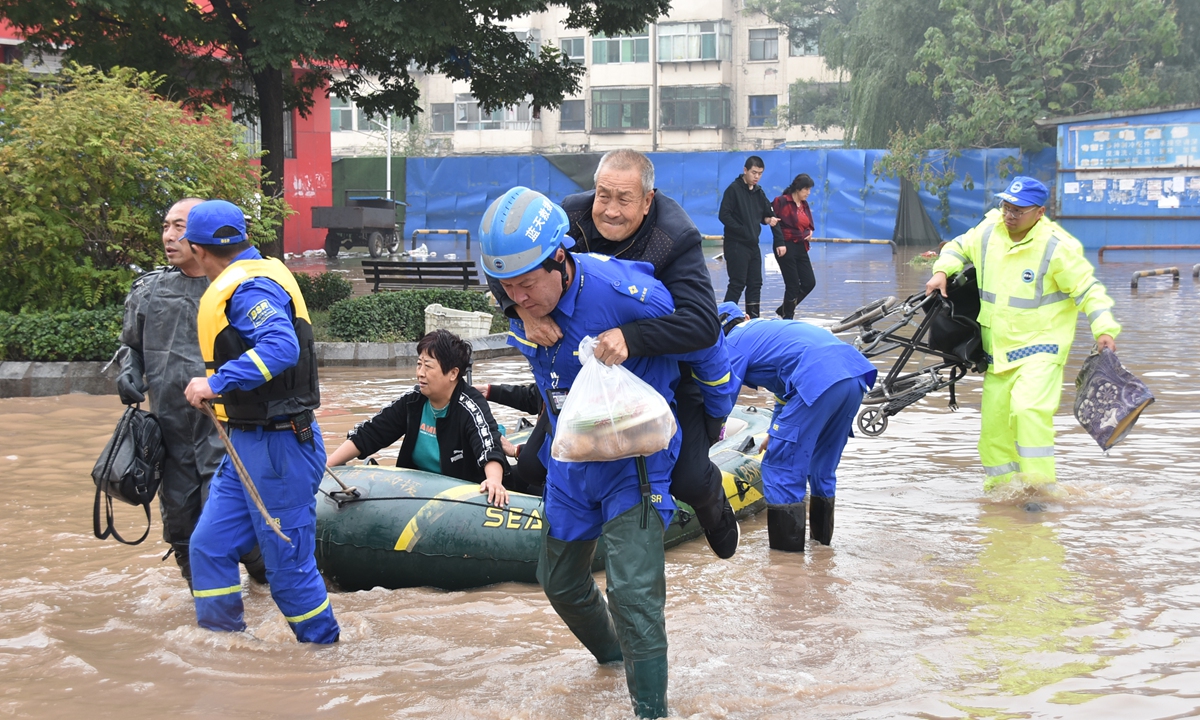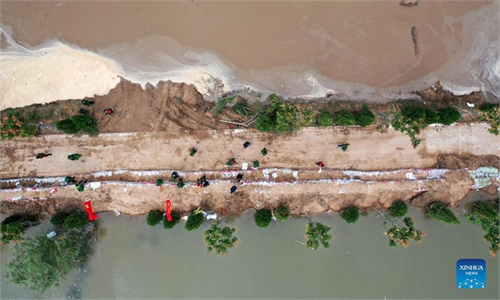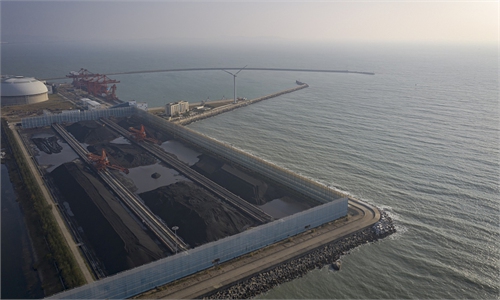Severe flooding in N China’s Shanxi affects more than 1.76 m; loss kept to minimum with organized rescue
Loss kept to minimum due to well-organized rescue efforts, preparations

Members of China's Blue Sky Rescue Team help residents in the flood-hit Lingshi county, North China's Shanxi Province, to relocate on October 10. Photo: Courtesy of the Blue Sky Rescue Team
Severe rainfall and flooding in North China's Shanxi Province have affected more than 1.76 million people as of Sunday. A total of 120,100 have been relocated, 2,849,600 mu (189,973 hectares) of crops have been damaged, and more than 17,000 houses have collapsed, the Xinhua News Agency reported on Sunday.
From October 2 to Thursday, the provincial average precipitation was 119.5 millimeter (mm). Eighteen counties received more than 200 mm of precipitation, and 51 counties received between 100-200 mm of precipitation. The maximum accumulated precipitation was 285.2 mm.
The average precipitation in Taiyuan, Shanxi's provincial capital, in the period was 185.6 mm. In comparison, the average monthly precipitation of Taiyuan in October from 1981 to 2010 was around 25 mm. Other cities like Linfen, Lüliang and Xinzhou saw an average precipitation of less than 50 mm in October in previous years.
Total casualties have not been released. According to reports, four traffic police officers died as a result of a landslide in Shanxi province on Tuesday.
The scope of flooding in Shanxi may have exceeded the devastating rainstorms in Central China's Henan Province in the summer which had killed more than 300 people as of early August but the impact is less so far, disaster relief experts said, noting that the frequency of extreme weather has become a trend in recent years and changes in strategy are needed to tackle extreme weather events.
The China Meteorological Administration noted that the heavy precipitation, accumulated rainfall, its long and often heavy duration accompanied by thunder and lightning and strong convection of cooling, also caused difficulties for rescue efforts in Shanxi.
Since the disaster strikes, rescue teams from all over the province have started work immediately and supplies from foundations and private donations poured into Shanxi.
In Taiyuan, rescuers in inflatable boats with megaphones shouted out to people in affected areas, and immediately went to the rescue when they heard a response. "Hold the children above your head, the elderly and women are given priority to go ashore. Don't panic, everyone will be rescued." Rescuers were constantly calling out to give confidence to stranded people.
A resident who lives in Ji county along the Yellow River told the Global Times that none of the Yellow River scenic spots were open during the National Day holiday this year. "This year, the level of the Yellow River is particularly high. Some houses in rural areas collapsed in the flood, but people were relocated in advance," she said. "In the past few days, civil servants in Linfen, Ji and other counties worked overtime going door to door to check the losses."
An onsite rescue worker said that the floods have been developing for many days and are still ongoing, with new dam failures and new disasters constantly emerging, the Shanghai Morning Post reported. Some of the disasters are not in areas along the river, but are caused by flash floods, where most of the casualties and house damage are reported.
Yuan Shan, captain of Blue Sky Rescue, a nonprofit civil rescue organization in China, told the Global Times on Sunday that the relocation is basically over.
"Some areas in southern parts of Shanxi have suffered heavy food losses, kiln collapses and landslides," Yuan said. "It will take a long time to recover from the disaster."
The scope of the flooding in Shanxi is even greater than the flooding in Central China's Henan Province in August, but the scale of impact and extent of the damage is less than the Henan floods, Hao Nan, head of a disaster information service center, told the Global Times on Sunday.
"The main challenge for Shanxi is the low temperatures brought about by the cold wave," Hao said. Currently, the temperature in some of the affected areas at higher altitudes is close to zero degrees.
Shanxi also faces challenges in other areas as a major coal-producing province, in response to the floods, but also to protect the supply of energy. In addition, there are many ancient buildings in Shanxi, and their preservation is also a challenge.
Other areas across the country experienced heavy rainfall during the holidays. Seven working groups were sent by the Ministry of Water Resources to the provinces of Shaanxi, Shanxi, Henan and Shandong to provide aid for flood prevention and control efforts, Xinhua reported.
"The torrential rain in Shanxi is the third widespread abnormal precipitation event in the northern China this year," Hao said. "This year's weather is characterized by an uneven distribution of water and drought, a lot of strong convective weather, and a particularly high number of tornadoes, at an order of magnitude higher than in the past."
However, local social rescue forces have become more organized. In the current flooding in Shanxi, the local community has been able to respond to all the existing rescue needs, which is a big step forward, Hao said.
The repeated extreme weather events have exposed the overall deficiencies in urban construction capacity to cope with sudden rainstorms and floods in most cities in North and Central China, which are usually relatively dry, Wan Yanhua, a professor of urban planning at Huazhong University of Science and Technology, told the Global Times on Sunday.
"Although the situation improved significantly after 2014, most cities still lack the flood protection capacity of southern cities and lag behind them in terms of flood protection standards and the intervals at which they inspect and improve the flood protection," Wan said.
However, Wan noted that for northern cities, which generally receive less rainfall, a significant increase in the level of urban flood protection is not necessary, taking into account the frequency of floods, the distribution of zones and the level of development.
"Rather than aligning flood protection levels with those of southern cities, northern cities should make further efforts to build 'sponge cities' and improve underground reservoirs to help mitigate droughts when they arrive," Wan said.
Hao pointed out that extreme weather has been on the rise in recent years, and overall meteorological disasters in China have increased in the last six years.
Now that the weather may be moving in a more extreme direction, it cannot be looked at it in the conventional and historical way. There is a need to make strategic adjustments, and weather disasters may increasingly affect everyone in the future, he said.



